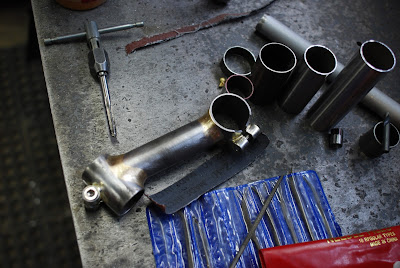With a bit of a heavy heart I came into the shop for the last time, but there was no time to be sad just yet. Lots of little things still needed to be done to all of our frames, and this was the last day, so we all worked like there was no tomorrow. Well, really, there isn't.
 |
| This was open when I came in this morning...and yep, I did get to use them! |
 |
| For all of your water bottle (or burrito, those fit well too) needs. |
 |
| Itty bitty brake bridge. |
After drilling, Mr. Yamaguchi busted out the Campy tools, and after telling me how expensive and rare and delicate they are handed me the headset facing tool to use on the fork. Only turning the facer clockwise, and adding tap oil every twenty or so revolutions, I slowly worked on my fork. When it was done, Mr. Yamaguchi carefully removed the tool and inspected my work. All was good! The tool and fork needed to be cleaned with compressed air, and my fork was done.
 |
| I'm ready for my crown race. |
 |
| A stem and collection of junk tubes from the various cuts I've made all week. |
 |
| It was both nerve wracking and exhilarating to use such an awesome toolset. Rare, highly sought after, and incredibly expensive, they work amazingly well and really get the job done. |
 |
| Shiny and ready to go! Everything is coming together at this point, and it really feels like a real frame. |
 |
| This is for the cable guide attachment, which I'll put on after painting. |
The last little bit of time we had left was used to finish as much of the cleanup and finishing as possible. Most students go home with a bit more sanding and filing to do, and we were no exception. I was filing away and slowly getting my frame closer to perfection (well, for a first frame anyway), when Mr. Yamaguchi asked for a group shot with all of our frames.
 |
| Upside-down frame. Time was short today so I couldn't get many photos, but when I return I'll post everything that Mr. Yamaguchi gave to me on disk, which actually include action photos. |
Though my time here is over, my journey is far from complete. The frame still has to be finished and built up, which I will be writing about here. I will also post photos and an epilogue of sorts after I return to California.
In short, this was one of the best experiences of my life, and I will never forget my time here. If the idea of making your own frame excites you in the least, you need to come here and experience this for yourself. You won't regret it.
Thanks for the link on reddit! Very thorough write up, felt like I was there. :)
ReplyDeleteWant to take this course so badly, but I'm on the other side of the planet. Maybe one day...